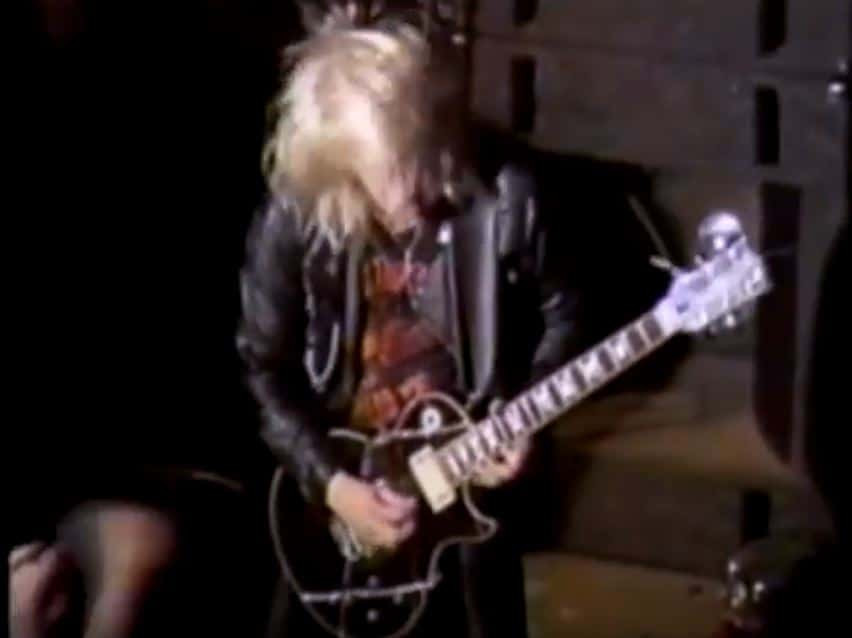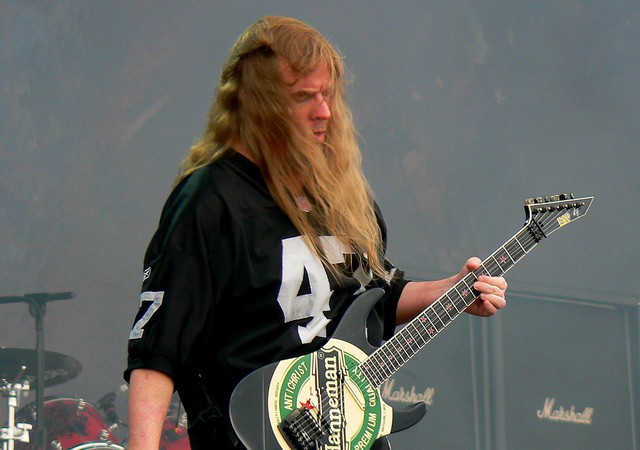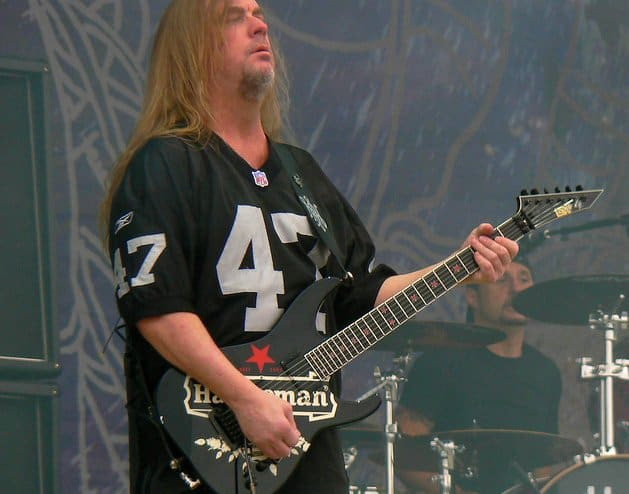Jeffrey John “Jeff” Hanneman, “The Riff Fuhrer,” remains a monumental figure in thrash metal, primarily recognized as the formidable guitarist of Slayer. From their inception in Huntington Park, California, in 1981, Slayer, co-founded by Hanneman and Kerry King, redefined heavy music. Their 1986 album, Reign in Blood, is a cornerstone of thrash metal, celebrated for its intensity and profound influence. For three decades, Hanneman’s distinctive, uncompromising riffs and raw guitar tone were integral to Slayer’s identity, solidifying his place as a guitar legend.
Hanneman’s dedication to Slayer was unwavering, performing until January 2011. A severe infection, necrotizing fasciitis, from an insect bite on his arm, tragically sidelined him. His final performance with Slayer occurred at the Big Four concert in Indio, California, on April 23, 2011. That evening, guitarist Gary Holt of Exodus initially filled in, later passing the torch to Hanneman for an encore featuring “Angel of Death” and “South of Heaven.”
The music world mourned the loss of Jeff Hanneman on May 2, 2013. He passed away in Los Angeles at 49, due to alcohol-related cirrhosis, a consequence of years of alcohol abuse. Hanneman’s innovative guitar work and impactful compositions profoundly influenced heavy metal and inspired countless musicians.
Jeff Hanneman’s Signature Electric Guitars: A Gear Deep Dive
Jeff Hanneman’s guitar arsenal was as iconic as his playing. He favored specific models, modifying them to achieve his aggressive and distinctive sound. Let’s explore the guitars that fueled the Slayer sound.
Gibson Les Paul: The Early Years
The Gibson Les Paul held a special place for Hanneman, marking his first electric guitar and remaining a favorite alongside his Jackson “Punk Rock.” This Les Paul was instrumental in Slayer’s formative albums, Show No Mercy and Hell Awaits.
“A Les Paul. I can’t remember how old I was. I got a job and saved my money until I had $500. Two months after that, I met Kerry [King], and that’s how Slayer got started.” – Jeff Hanneman, Guitar World Archive
Hanneman personalized his Les Paul extensively. He installed a Kahler tremolo system, replacing the original bridge for enhanced vibrato capabilities, and swapped the bridge pickup, likely for a high-output Seymour Duncan Distortion, to boost its aggressive tone. Visually, he made it uniquely his own with a red paint splatter finish and, for a period, added chains, enhancing its rebellious aesthetic.
“I put a Seymour Duncan pickup in the bridge position—I can’t remember which on but it may have been a Distortion,” Hanneman continues. “I had a Kahler tremolo put on her, too…To do the paint job I taped up the pickups, dipped a stick in some red paint and just splashed it on there. I think I screwed some chains on her for a while, too.” – Jeff Hanneman, Guitar World Archive
 Jeff Hanneman playing his iconic paint-splattered Gibson Les Paul guitar.
Jeff Hanneman playing his iconic paint-splattered Gibson Les Paul guitar.
1976 Gibson Explorer – Natural Finish: A Glimpse into Early Slayer
Hanneman’s 1976 Gibson Explorer with a natural finish is less documented but appears in early Slayer photos, likely from their cover band days. While its role in Slayer’s original material is unclear, its presence highlights Hanneman’s early guitar preferences.
This Explorer model, potentially a limited edition, featured original Gibson ‘Tar back’ humbucker pickups, a mahogany body and neck, and a rosewood fretboard with 22 frets and dot inlays. It represents a more classic guitar choice compared to some of his later, more heavily modified instruments.
B.C. Rich Bich Guitars: Embracing Aggression
Around 1985, B.C. Rich Bich guitars became prominent in Hanneman’s arsenal, contributing significantly to Slayer’s mid-era sound.
B.C. Rich Bich – 3×3 Headstock: Reign in Blood Era
Hanneman acquired a black B.C. Rich Bich with a 3×3 headstock, quickly applying his signature modifications. He replaced the bridge with a Kahler Pro and installed DiMarzio Super Distortion humbuckers, further intensifying its output. This guitar was used extensively during the Hell Awaits Tour (1985) and crucially, for recording the landmark Reign in Blood album and its subsequent tour (1986–1987).
Initially all black with chrome hardware, this Bich evolved visually with white decal stickers. These stickers, including Smirnoff vodka, St. Pauli Grill, D.R.I. logos, Wasted Youth branding, and punk-era imagery, foreshadowed the graphic elements that would define his signature ESP guitars.
B.C. Rich Bich – Pointed Headstock: Reign in Pain Era
Sharing specifications with the 3×3 headstock Bich, Hanneman’s pointed headstock version featured black hardware and remained sticker-free. This guitar was prominent during the Reign in Blood Tour (1986–1987) and Reign in Pain European Tour (1987), notably seen in Slayer’s Live at Ritz concert footage.
 Jeff Hanneman playing his black B.C. Rich Bich guitar with a pointed headstock at The Ritz in 1986.
Jeff Hanneman playing his black B.C. Rich Bich guitar with a pointed headstock at The Ritz in 1986.
B.C. Rich Gunslinger: Active Pickups Enter the Fray
In 1987, Hanneman transitioned to a custom B.C. Rich Gunslinger. While retaining the Kahler bridge, this guitar marked a significant shift to active pickups, featuring dual EMG 81 humbuckers. This pickup choice became a defining element of Hanneman’s tone for the remainder of his career.
The Gunslinger was also adorned with controversial decals, including references to Reinhard Heydrich and WWII German military units. While sparking debate and accusations of Nazi sympathies, Hanneman maintained these were expressions of his fascination with “evil imagery,” not endorsements of hateful ideologies.
Jackson Soloist “Punk Rock”: The E-Flat Tuning Workhorse
Acquired in 1988 for approximately $2,000, the Jackson Soloist “Punk Rock” became Hanneman’s second favorite and arguably most recognized guitar. Primarily used for E-flat tunings until around 2001, it was a staple in his live and studio work.
Typical of Jackson custom shop guitars of the era, it featured a neck-thru poplar body, maple neck with 24 frets, ebony fretboard with sharkfin inlays, and a Kahler Flatmount tremolo. Originally equipped with passive Jackson pickups and a JE-1200 mid-boost circuit, Hanneman quickly swapped to EMG 81s and removed the mid-boost. The original Corian nut and behind-the-nut Kahler string lock were later updated to a Floyd Rose-style locking nut in the 1990s.
The “Punk Rock” Soloist was famously decorated with punk rock and counter-culture stickers, including Black Flag, Circle Jerks, Dead Kennedys, and The Exploited, reflecting Hanneman’s broader musical tastes beyond metal. Ironically, this iconic guitar was damaged during the filming of the “Bloodline” video when covered in fake blood.
ESP Signature Guitars: The Modern Era
From 1990 onwards, ESP guitars became Hanneman’s primary instruments. These guitars generally maintained a consistent setup: EMG pickups, Kahler Flatmount tremolo, Floyd Rose locking nut, and 24-fret necks. Variations primarily involved paint jobs, stickers, and fretboard inlays.
ESP Raiders: Early Signature Model
The ESP Raiders, Hanneman’s first ESP signature model (1990), is visible on Live Intrusion and War at the Warfield DVDs. It mirrored the Jackson Soloist in specs but featured different stickers, continuing the Raiders theme along with punk and anti-authority imagery.
ESP Kill (Bloodline): Reverse Headstock and Controversial Inlays
The ESP Kill (Bloodline), from 1998, is unique as Hanneman’s only ESP with a reverse headstock. Used during the Diablos In Musica sessions and the “Bloodline” video (hence its nickname), it featured EMG pickups, Kahler tremolo, and rosewood fretboard. Its controversial Hitlerjugend insignia inlays made it a visually striking and contentious instrument. Stickers included Social Distortion, Metal Mulisha, and skull motifs.
ESP Urban Camo, “Flecktarn” Camo, and Digital Camo: Camouflage Aesthetics
These ESP models primarily differed in their camouflage paint schemes: Urban Camo (winter camouflage), “Flecktarn” Camo (German military pattern), and Digital Camo. Inlays varied, with options including Slayer eagle designs, dot inlays, or “H” dagger inlays (inspired by the Hohenstaufen division insignia). The Urban “Flecktarn” Camo is seen on the Still Reigning DVD.
ESP Hatebreed and Metal Mulisha: Graphic and Bold
The ESP Hatebreed guitar featured the same Hitlerjugend insignia inlays as the ESP Kill, alongside stickers like Hatebreed logos and skull imagery. The ESP Metal Mulisha guitar was highly recognizable with Totenkopf and sig runes inlays and graphics featuring skulls, Metal Mulisha logos, and faux bullet holes.
ESP Raiders #2: Oakland Raiders Tribute
As a dedicated Oakland Raiders fan, Hanneman created the ESP Raiders #2, featuring a black finish with white Raiders lettering and a skull with crossed daggers. This guitar was used during the Christ Illusion album recordings.
ESP Jeff’s Heineken and Totenkopf Blood Star: Beer and Legacy
The ESP Custom Shop crafted the ESP Jeff’s Heineken, a tribute to Hanneman’s favorite beer. It featured a large Heineken logo altered to “Hanneman” and “blood star” inlays. This guitar is visible on The Big Four: Live from Sofia, Bulgaria DVD.
 Jeff Hanneman holding his custom ESP Heineken guitar at Knebworth in 2010.
Jeff Hanneman holding his custom ESP Heineken guitar at Knebworth in 2010.
The ESP Totenkopf Blood Star, also custom-made, combined a Heineken logo with a Totenkopf graphic and “Blood Star” inlays. Significantly, Hanneman used this guitar for his final performance with Slayer at the Big Four in Indio on April 23, 2011, making it a poignant symbol of his last stand with the band.
 Jeff Hanneman playing his ESP Totenkopf Blood Star guitar at Knebworth in 2010.
Jeff Hanneman playing his ESP Totenkopf Blood Star guitar at Knebworth in 2010.
Jeff Hanneman’s Amplification and Effects: Crafting the Slayer Sound
Hanneman’s guitar tone was not solely defined by his guitars; his amplification and effects choices were equally crucial.
Guitar Amps:
- Marshall JCM800 2203 Amplifiers: The core of Hanneman’s amp setup, the JCM800 2203 provided the high-gain foundation for his aggressive tone.
- Marshall JCM800 1960 Cabinets/ModeFour Speaker Cabinets: Typically paired with JCM800 heads, these cabinets, often loaded with Celestion G12T-75 speakers, contributed to the massive Slayer sound.
Guitar Effects:
Hanneman’s effects were used to refine and enhance, not drastically alter, his core guitar tone:
- Shure Wireless System: For stage freedom.
- Eventide H3000S Harmonizer: Used for subtle harmonization and thickening of the guitar sound.
- Yamaha SPX-90 Effects Processor: Likely for reverb and delay.
- Rocktron Super C HUSH & MXR Smart Gate: Noise gates to control high-gain amplifier noise and tighten up riffs.
- BOSS RGE-10 (10 band EQ): For fine-tuning his frequency response.
Guitar Strings and Picks:
- Dunlop/D’Addario .009-.042 Strings: Light gauge strings for playability and fast riffing.
- Dunlop Tortex .73mm Triangle Picks: Favored for their attack and durability, often customized with graphics.
Conclusion: Hanneman’s Enduring Guitar Influence
Jeff Hanneman’s guitar choices and modifications reveal a player dedicated to achieving a specific, brutal sound. From his early Les Paul to his signature ESP models, each guitar played a role in shaping the thrash metal landscape. His adoption of EMG pickups and Kahler tremolos, coupled with his Marshall amplification, became hallmarks of his aggressive style. Hanneman’s legacy extends beyond his riffs; it’s embedded in the gear choices that inspired generations of metal guitarists to pursue heavier, more intense sounds. His guitars are not just instruments; they are artifacts of a revolutionary sound that continues to resonate within heavy metal.
